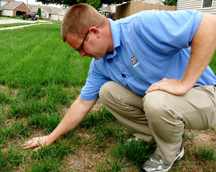Specialist: Controlling lawn weeds in drought carries risks
July 2, 2012
 |
|
Purdue University turf grass specialist Aaron Patton inspects a lawn that is partially green and partially brown, showing signs of drought stress. (Purdue Agricultural Communication photo/Tom Campbell) |
WEST LAFAYETTE, Ind. - About the only thing green in many lawns these days is weeds. Should homeowners take action in the middle of a drought? It depends, a Purdue Extension turfgrass specialist says.
With little to no rainfall in the forecast and temperatures well above 90 degrees, homeowners generally should avoid using herbicides, said Aaron Patton. In cases where lawns are holding up better to the heat and dryness, weed-killing products should be used carefully so as not to damage turf.
Patton said there are a variety of weeds in drought-stricken lawns, including summer annual weeds such as crabgrass, common ragweed and marestail; biennial weeds such as wild carrot and bull thistle; and perennial weeds such as yellow nutsedge and Canada thistle. How those weeds are eradicated depends on the condition of the lawn, he said.
For lawns that are not regularly watered and/or are brown, Patton said the condition of the lawn should determine whether herbicides are safe to use.
"Herbicides are much less effective on drought-stressed weeds and can be damaging to drought-stressed turf, especially when temperatures are warm," he said. "My rule of thumb is that if the lawn has mild drought stress - more than 50 percent green - then herbicides can be applied. If the lawn is mostly brown, it is best to wait."
If a lawn is brown and drought conditions persist, homeowners can pull weeds by hand, Patton said. They also can spot-mow areas where weeds are present, being careful not to mow those parts of the lawn without the unwanted vegetation.
Herbicide treatments can be resumed when the drought ends and temperatures cool, Patton said.
"For yellow nutsedge and summer annual weeds, it is better to hold off on applying herbicides until rain returns and the turf begins growing again," he said. "For perennial broadleaf weeds like dandelions, it might be best to wait until fall, as fall applications work better than spring and summer applications for broadleaf control."
The recommendations are different for homeowners who regularly water their lawns.
"The question I most typically get in an irrigated scenario or during a summer when turf is not drought-stressed is, 'Can I apply a herbicide when temperatures are 85 degrees or higher?' First, you need to follow the herbicide label, as each herbicide acts differently."
Applying herbicides when daily high temperatures soar above 85 degrees usually increases the risk of turf injury, Patton said.
"Most herbicide labels do not prohibit applications at temperatures greater than 85 or 90 degrees, but they do caution against their use at these temperatures," he said. "A general recommendation is to make the application if the site is more weeds than turf and you are willing to assume the risk of injuring the turf."
If an irrigated lawn is high-quality turf with only a few weeds, Patton recommends delaying herbicide applications until temperatures turn cooler.
For more information about lawn care, visit the Purdue Turfgrass Science website at http://www.agry.purdue.edu/turf/
Writer: Steve Leer, 765-494-8415, sleer@purdue.edu
Source: Aaron
Patton, 765-494-9737, ajpatton@purdue.edu
Related website:
Purdue Department of Agronomy
Ag Communications: (765) 494-2722;
Keith Robinson, robins89@purdue.edu
Agriculture News Page

